Right-of-way rules often confuse drivers, leading to moments of hesitation and silent negotiations. Get them wrong, and you could end up with a ticket for failure to yield or, worse, cause an accident on the road.
In California, these regulations are outlined in Sections 21800-21804 of the Vehicle Code. 21800 CVC covers the general right-of-way rules at intersections, while 21801 to 21804 CVC deal with more specific cases, such as left turns, U-turns, and entering traffic from private driveways.
Here’s what the law says and how to deal with a failure-to-yield ticket.
CVC 21800: Failure to Yield
CVC 21800 states that drivers must give priority to vehicles already in the intersection. When two vehicles arrive at the same time, drivers should yield to those on their right.
CVC 21800 (a)
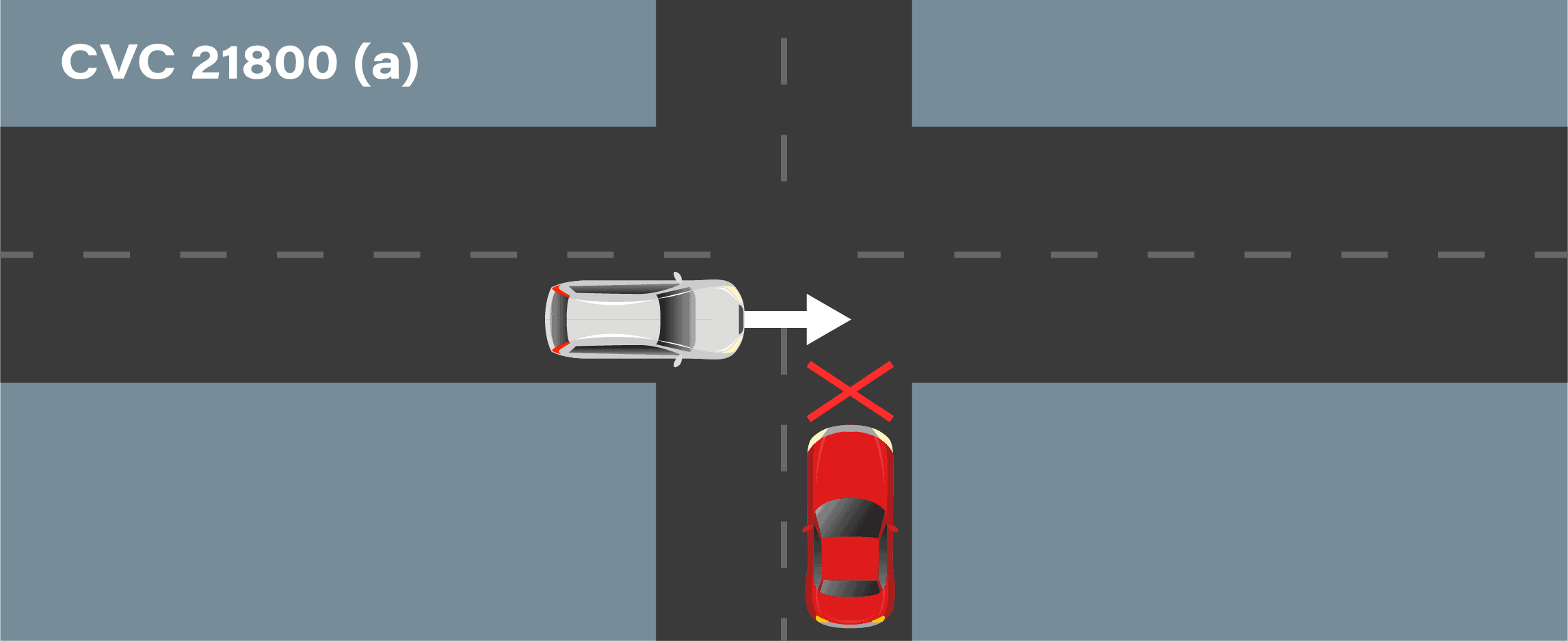
CVC 21800 (a) states that drivers approaching an uncontrolled intersection must yield to existing traffic.
So, if another car enters the intersection before you, stop and let it pass before proceeding.
CVC 21800 (b)(1)
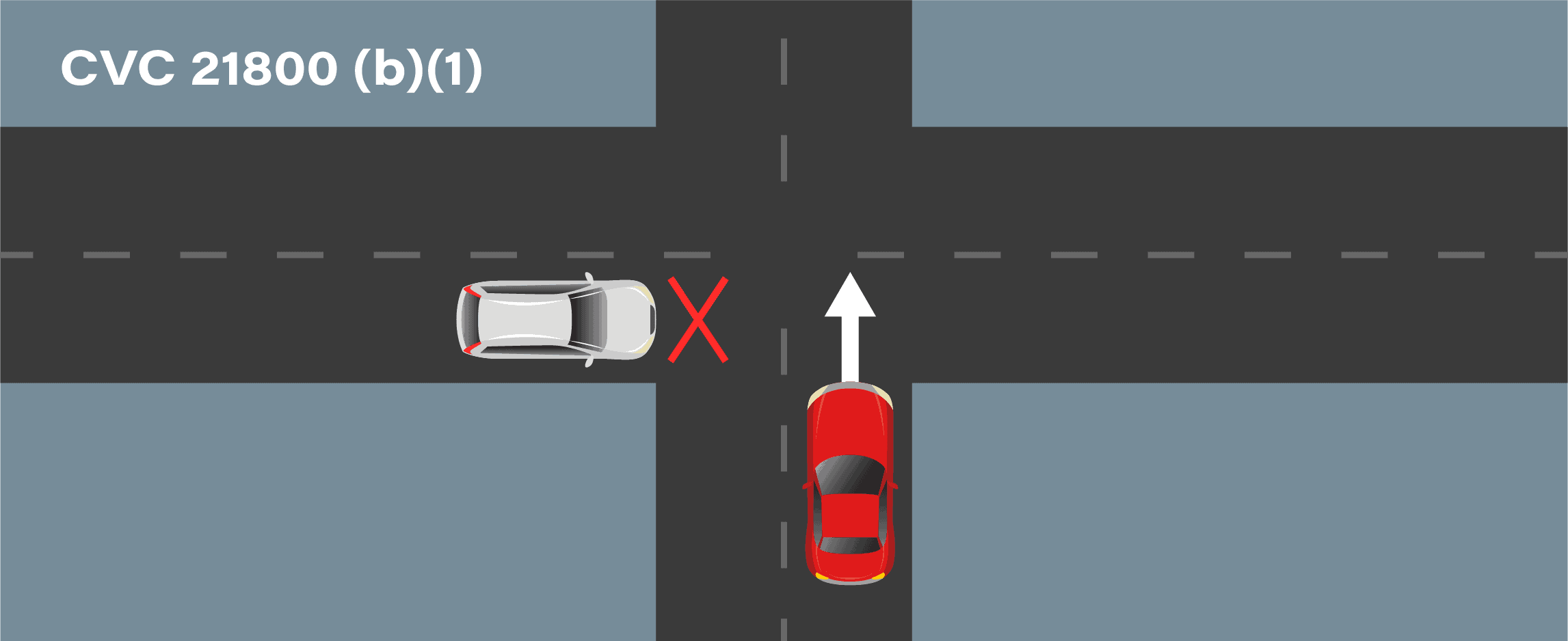
CVC 21800 (b)(1) states that if two vehicles arrive at an intersection at the same time, the driver on the left must yield to the driver on the right.
CVC 21800 (c)
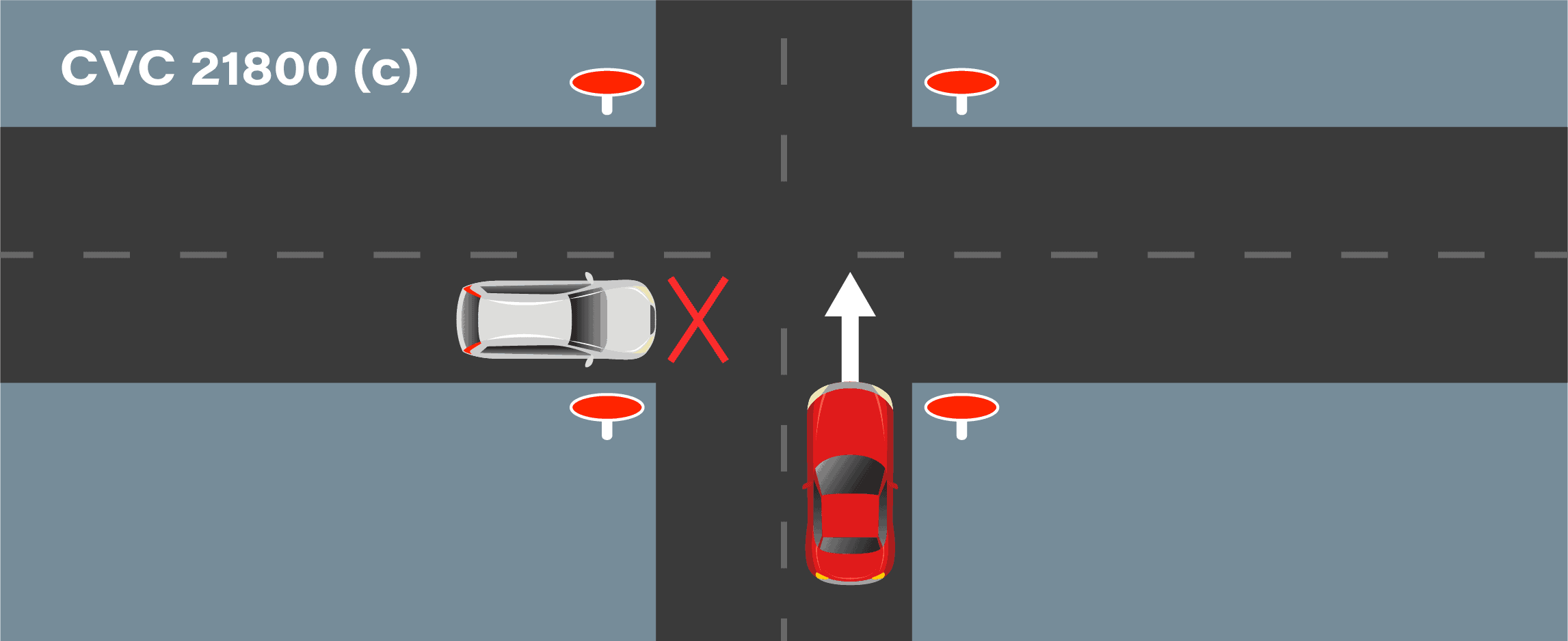
CVC 21800 (c) states that when approaching an intersection with stop signs on all sides, the driver on the left must yield to the driver on the right.
CVC 21800 (d)(1)
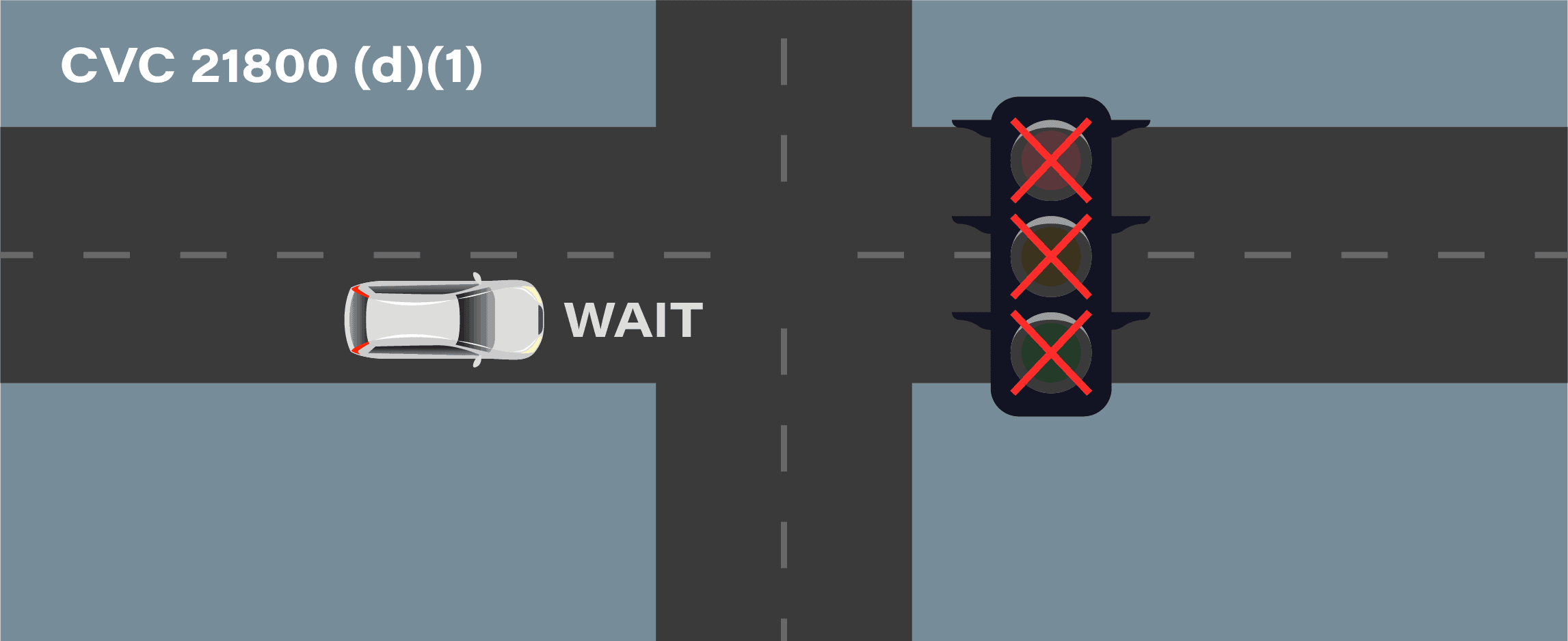
CVC 21800 (d)(1) states that drivers approaching an intersection with a malfunctioning traffic signal must stop and proceed only when it is safe to do so.
Treat these intersections as though they were a four-way stop. Come to a complete stop. Take a good look in all directions, checking for other vehicles, pedestrians, cyclists, and road hazards. Wait until it’s safe to continue through the intersection.
CVC 21800 (d)(2)
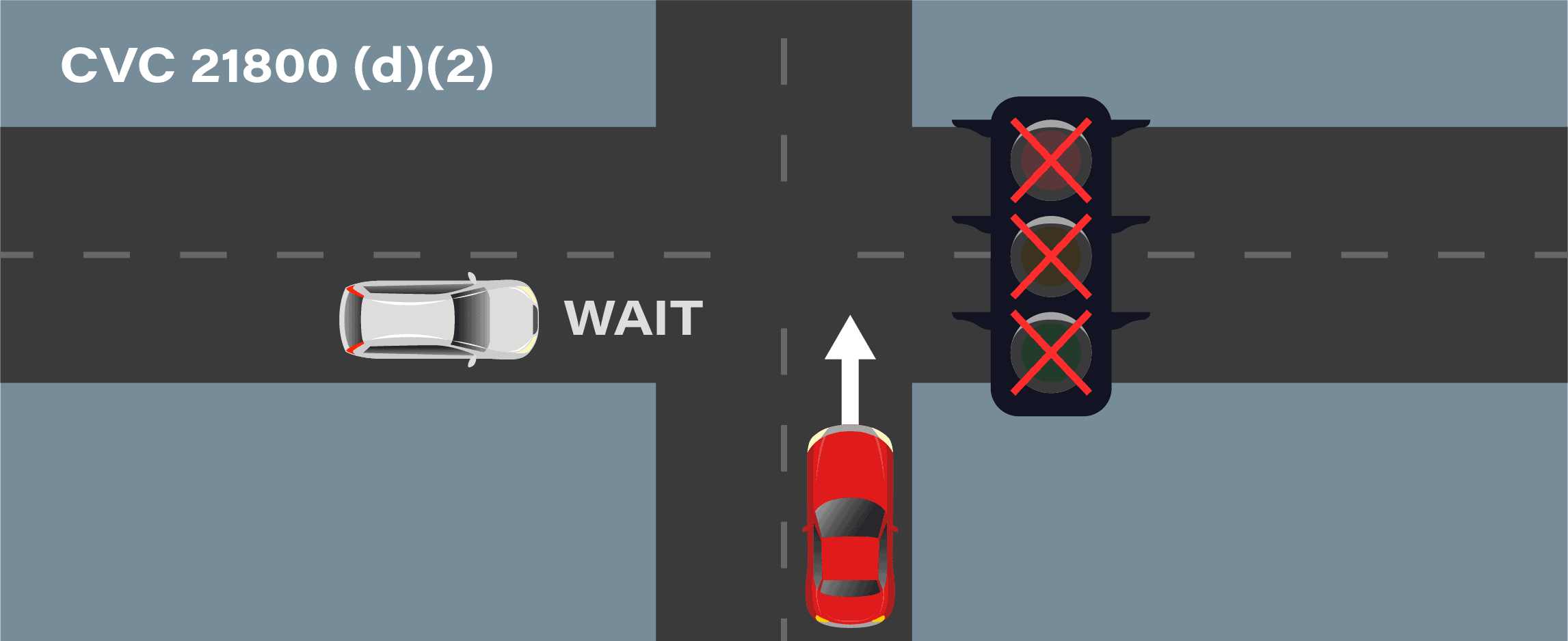
CVC 21800 (d)(2) states that when two drivers arrive at the same time at an intersection with a traffic signal that isn’t working, both must come to a complete stop. The driver on the left shall yield to the one on the right.
Let’s assume two cars approach a four-way intersection simultaneously, and the traffic signal is out. Both vehicles stop, but the one on the left rolls through without yielding. The driver in question violates CVC 21800 by failing to yield to the vehicle on the right.
Traffic school can help you keep a clean driving record, prevent insurance increases, and more!
Common Questions about CVC 21800
What is an uncontrolled intersection?
An uncontrolled intersection is a crossroad without traffic lights, yield signs, or stop signs. Such intersections are common in areas with little traffic, such as neighborhood streets and rural roads. Right of way rules apply here.
Who has the right-of-way when two cars arrive at the same time?
When two cars arrive at an intersection at the same time, the one on the right has priority.
Should I always yield to the car on my right?
No, you shouldn’t always yield to the car on your right, as this law only applies at uncontrolled intersections. If there are traffic signs, signals, or other right-of-way rules in play (e.g., left-turn regulations), those take precedence.
What happens at a T-intersection with no signs?
At uncontrolled T-intersections, drivers on the terminating road must yield to those on the continuing road.
If there’s no sign or light, can I just go if the road looks clear?
Not exactly. Even without traffic signs and signals, you still have to proceed with caution and follow the right-of-way rules.
Check for pedestrians, cyclists, and other road users. Be sure to yield to any vehicles already in the intersection, and cross the intersection only when it’s safe (and legal!) to do so.
Can a pedestrian ever have the right-of-way under this section?
While CVC 21800 focuses on vehicles, it doesn’t override pedestrian priority. Drivers must always yield to pedestrians in crosswalks, whether marked or unmarked.
CVC 21801: Left Turns and U-Turns
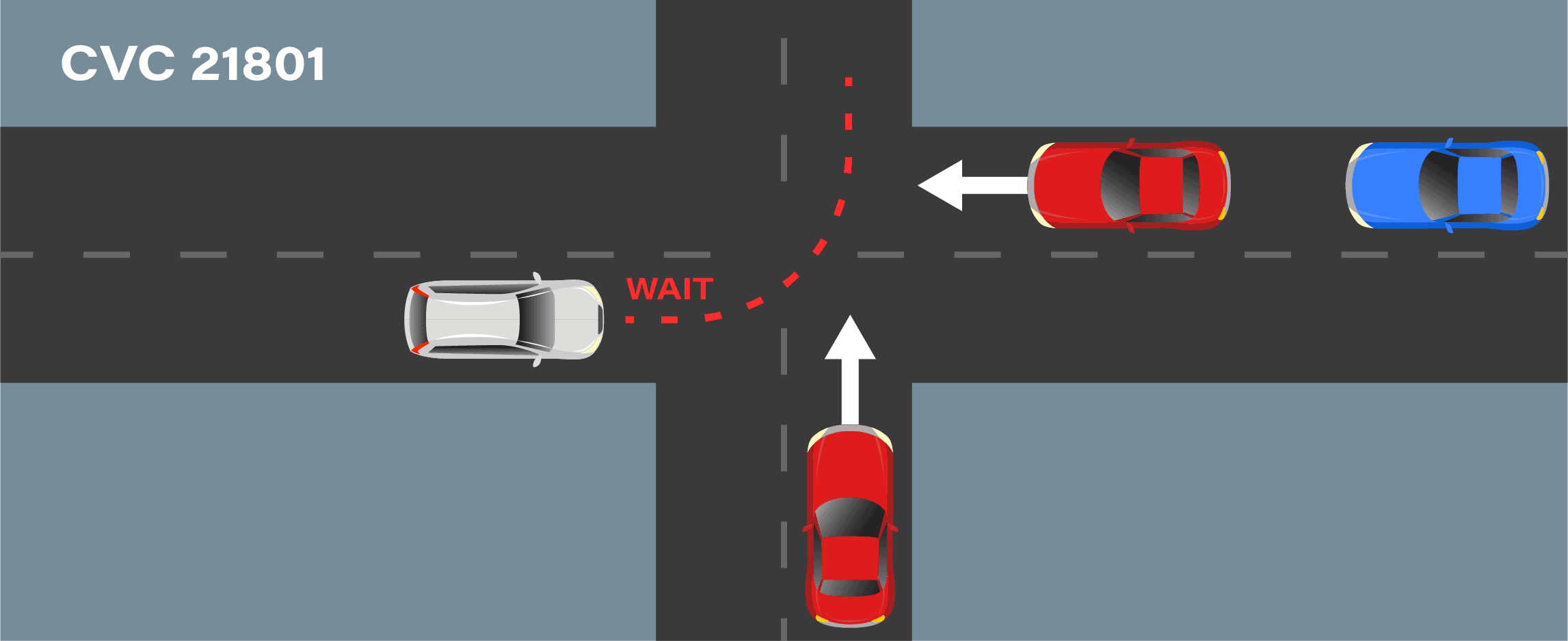
CVC 21801 requires that drivers at uncontrolled intersections who intend to turn left or make a U-turn yield to oncoming traffic and proceed only when it’s safe.
Example 1: Turning Left Across Multiple Lanes
Imagine you’re driving in the far-right lane and want to get to a car wash on the left side of the road. That means you’ll need to cross three lanes of traffic. To do this safely:
- First, move into the middle lane well before your turn.
- As you approach the left turn, yield to oncoming traffic.
- Don’t make your turn until the road is clear.
Cutting across multiple lanes without preparing in advance can be dangerous – and illegal if you don’t yield properly.
Example 2: U-Turn at a Blind Intersection
Now picture this: you’re making a U-turn at an intersection where your view is blocked – maybe by trees, parked cars, or a curve in the road. You think it’s safe, but suddenly an oncoming car appears, and it’s moving fast.
Even if you didn’t see the other car coming, you could still be charged with failing to yield.
Why? Because it’s your responsibility to make sure the road is clear before turning, especially at blind intersections.
Common Questions about CVC 21801
When can I turn left at a green light?
Per CVC 21801, you can turn left at a green light after yielding to oncoming traffic. Remember that you must also allow pedestrians and cyclists to clear the intersection before turning.
Do I have to wait until the oncoming lane is completely clear?
No, you don’t need to wait until the road is clear. However, you may proceed through the intersection only if there’s a safe gap in oncoming traffic.
What if the light turns red while I’m waiting at the intersection to turn?
You may complete your turn even if the light turns red — as long as it’s safe to do so. Just make sure you yield to any vehicles, pedestrians, or cyclists still crossing. Turning right on red will not result in a red light camera ticket in California.
Can I finish my turn after the light changes?
Yes, you can finish your turn after the light changes as long as:
• You were already in the intersection when the light turned yellow or red.
• You yield the right-of-way to oncoming traffic.
• You can complete the maneuver safely.
What if I misjudge the speed of the oncoming car?
As a licensed driver, you’re responsible for accurately judging the speed of other vehicles. If your turn causes another driver to swerve or brake to avoid a car crash, you could be cited under CVC 200801.
Is a U-turn treated the same as a left turn under this law?
Yes, it is. Whether you’re turning left or making a U-turn, let oncoming traffic go first, and proceed only when it’s safe.
CVC 21802: Stop Sign Intersections
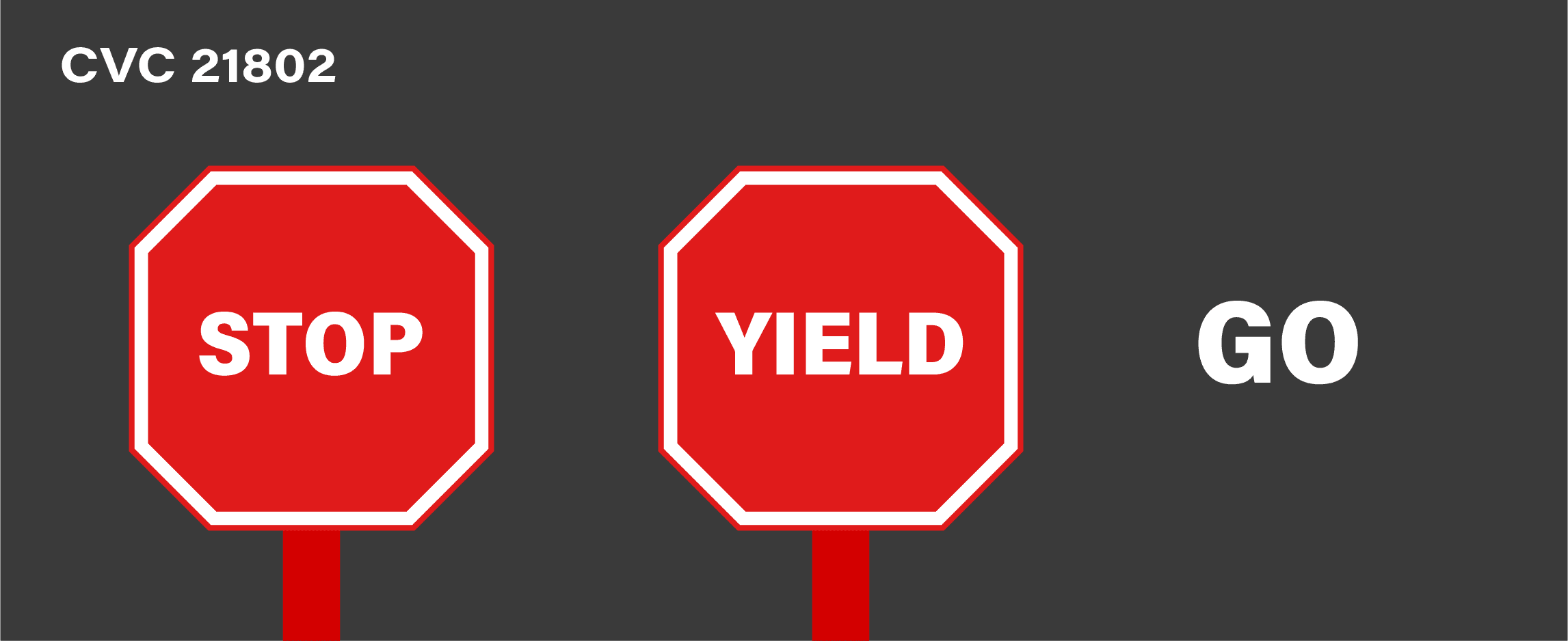
Per CVC 21802, drivers approaching an intersection with stop signs must come to a full stop, yield to existing traffic, and proceed with caution.
Common Questions about CVC 21802
Do I have to yield after stopping at a stop sign?
Yes, you do. Stopping isn’t enough. You must also yield to any vehicles that are already in the intersection.
Who do I yield to at a two-way vs. four-way stop?
When you arrive at a two-way stop, yield to all cross-traffic that doesn’t have a stop sign. If you’re turning left, yield to vehicles going straight or turning right.
At a four-way stop, the first to arrive has the right of way. If two cars arrive at the same time, yield to the one on your right.
What if the other driver doesn’t stop?
If the other driver doesn’t stop, you still have to follow the rules. Come to a full stop, yield to any vehicles that have the right of way, and proceed only when it’s safe.
How long do I have to stop?
There’s no specific time requirement for how long you must stop. What matters most is that you come to a complete stop, even if just briefly. A rolling stop is considered a violation of CVC 21461 (failure to obey traffic signs and signals) and may result in a $238 fine and one point on your driving record.
Do I have to yield if I was at the stop sign first?
The answer depends on whether there’s a two- or four-way stop. If you arrive at a two-way stop, you must yield to cross-traffic. But if you’re the first to arrive at a four-way stop, you may proceed without yielding unless you arrive at the same time as another vehicle on your right.
Can I be at fault even if I stopped properly?
Yes, you can still be at fault even if you come to a full stop. Remember, you also have to yield to any vehicles, cyclists, and pedestrians that have the right-of-way.
CVC 21803: Yield Sign Intersections
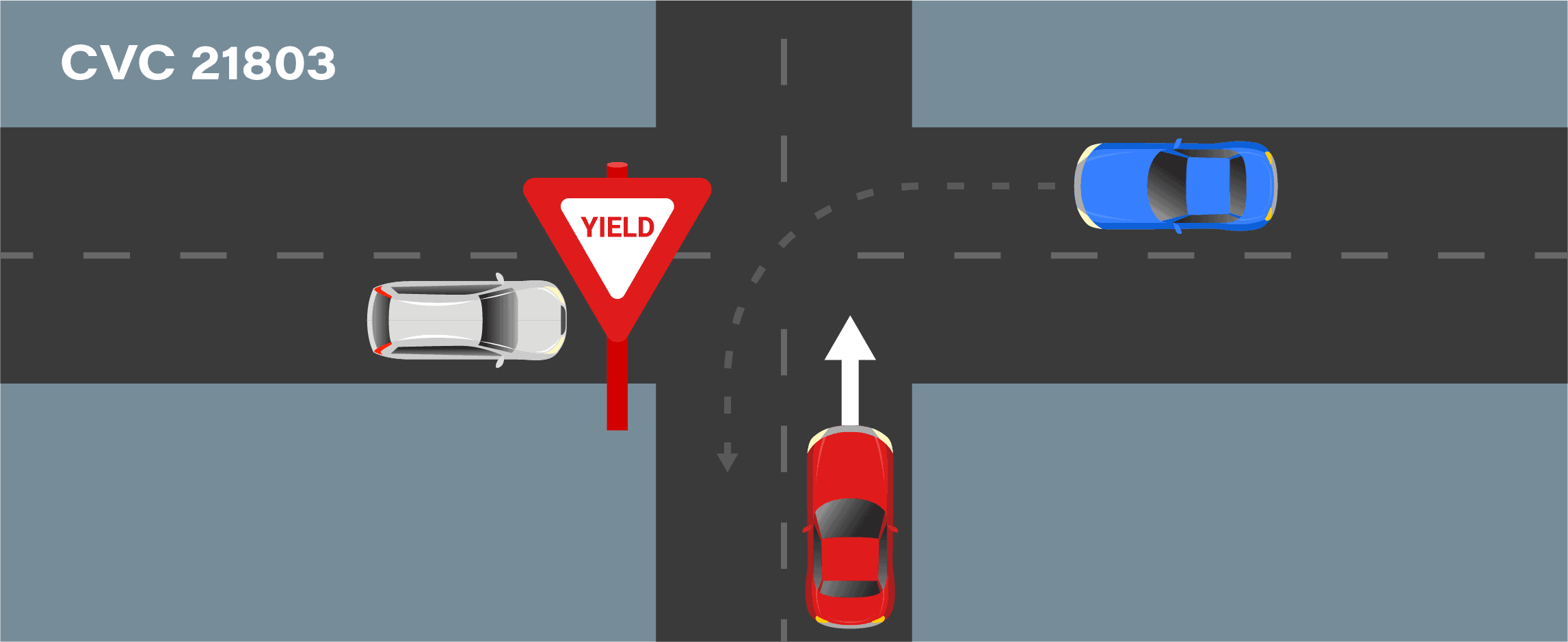
CVC 21803 requires you to slow down and yield to existing traffic at intersections controlled by yield signs. You must also be ready to stop if needed.
At a yield sign, it’s crucial to check for cross-traffic and pedestrians and continue only when the road is clear. If you go through and cause another driver to brake hard or swerve, you may be violating CVC 21803.
Suppose you’re at an intersection marked by a yield sign. You slow down, then pull in despite seeing a car coming from the right. You assume there’s enough time to cross safely, but the car is moving faster than expected and must swerve to avoid a collision. In this case, you could receive a CVC 21803 ticket.
Common Questions about CVC 218013
What does it mean to yield at a yield sign?
When you see a yield sign, you must reduce your speed, check for vehicles and other road users, and allow them to pass safely.
Can I get a ticket for not stopping at a yield sign?
The yield sign doesn’t require coming to a full stop, but you must be prepared to do so if the situation calls for it. If you cause an accident because you didn’t stop, you can be ticketed for violating CVC 21803.
How do I know when it’s safe to go?
At a yield sign, it’s safe to go when the road is clear or there’s a gap in traffic. Simply put, you can proceed if no one has to brake, swerve, or make unsafe lane changes because of you.
Do I have to yield to pedestrians at a yield sign?
Yes, you must yield to any pedestrians crossing at marked or unmarked crosswalks, even if there’s no cross-traffic.
What if I don’t see any cars — can I just go?
Yes, but only after you slow down and check for pedestrians or cyclists.
CVC 221804: Entering a Road from Private Property or Side Street
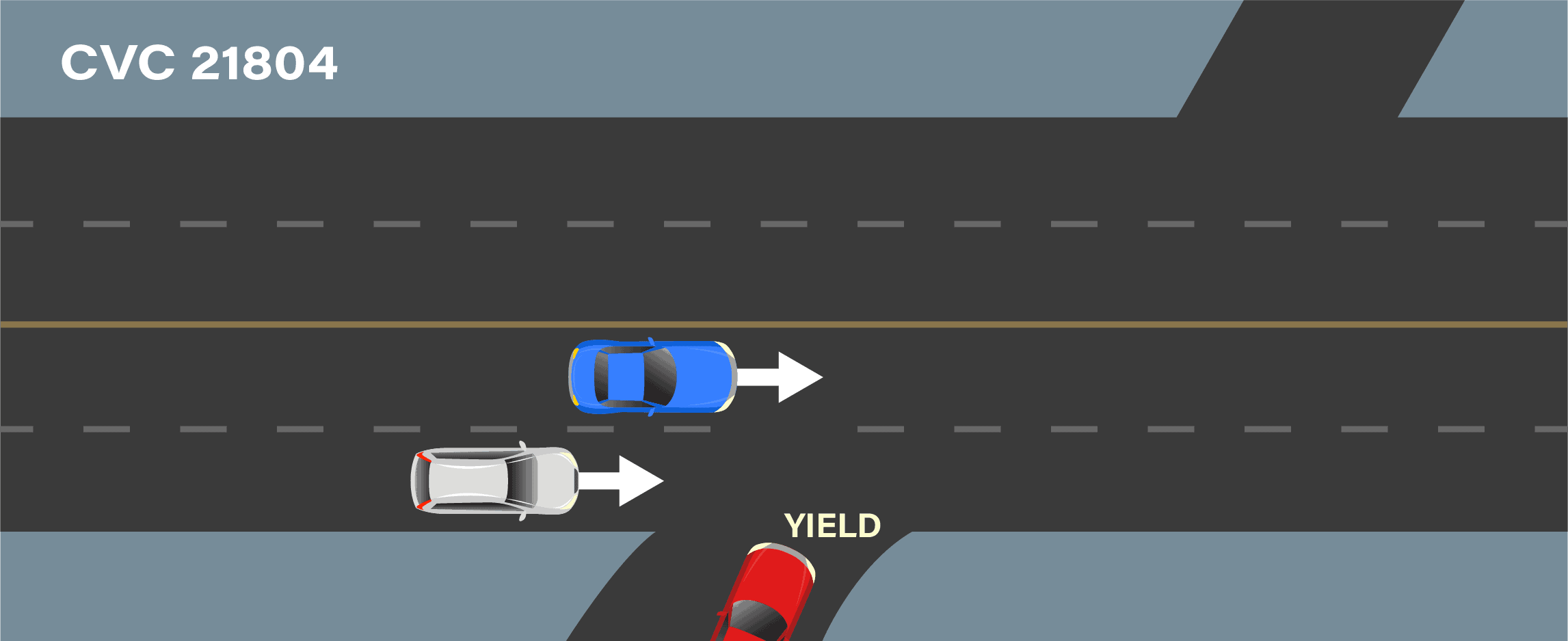
CVC 21804 states that drivers entering or crossing a roadway from a driveway, alley, or side street must yield to all traffic and pedestrians.
Example 1: Turning Onto a Highway from a Gas Station
You’re leaving a gas station and want to turn right onto a busy highway. Before pulling out, you must yield to any vehicle close enough to be a danger.
If you misjudge how fast a car is coming and enter the road too soon, the other driver might have to slam on their brakes or swerve to avoid hitting you. That puts everyone at risk – and you could be found at fault for not yielding.
Example 2: Yielding in a Parking Lot
The same rule applies in parking lots.
Let’s say you’re pulling out of a parking lot and a pedestrian is crossing in front of your car. If you don’t stop and yield to them, you could be ticketed or fined – even though you’re on private property.
Always yield to cars, bikes, and pedestrians when entering a road or crossing a sidewalk.
Common Questions about CVC 21804
When entering a street from a driveway, do I always have to yield?
Yes, you must yield to all vehicles and pedestrians because you’re coming from a secondary road.
What if there’s no sidewalk or crosswalk — do pedestrians still have the right-of-way?
Pedestrians don’t have the right-of-way outside of designated areas like sidewalks or crosswalks. But even so, drivers must still exercise caution and take any steps to avoid a collision.
Do I have to stop before the sidewalk when exiting a driveway?
Yes, you must stop and check for pedestrians, bikes, strollers, or anyone else in your path.
Who’s at fault if there’s a crash when I’m pulling out of a parking lot?
It depends on the situation. If you exit without yielding to other cars or pedestrians, you’ll likely be considered at fault.
What if I have a stop sign, but the traffic on the main road doesn’t?
In such cases, you must stop, yield the right-of-way, and wait until it’s safe to enter.
21800 CVC Tickets: Fines, Points, Insurance Impact
Failure to yield can be fatal, especially when combined with speeding or distracted driving. In fact, it’s one of the leading causes of fatal crashes.
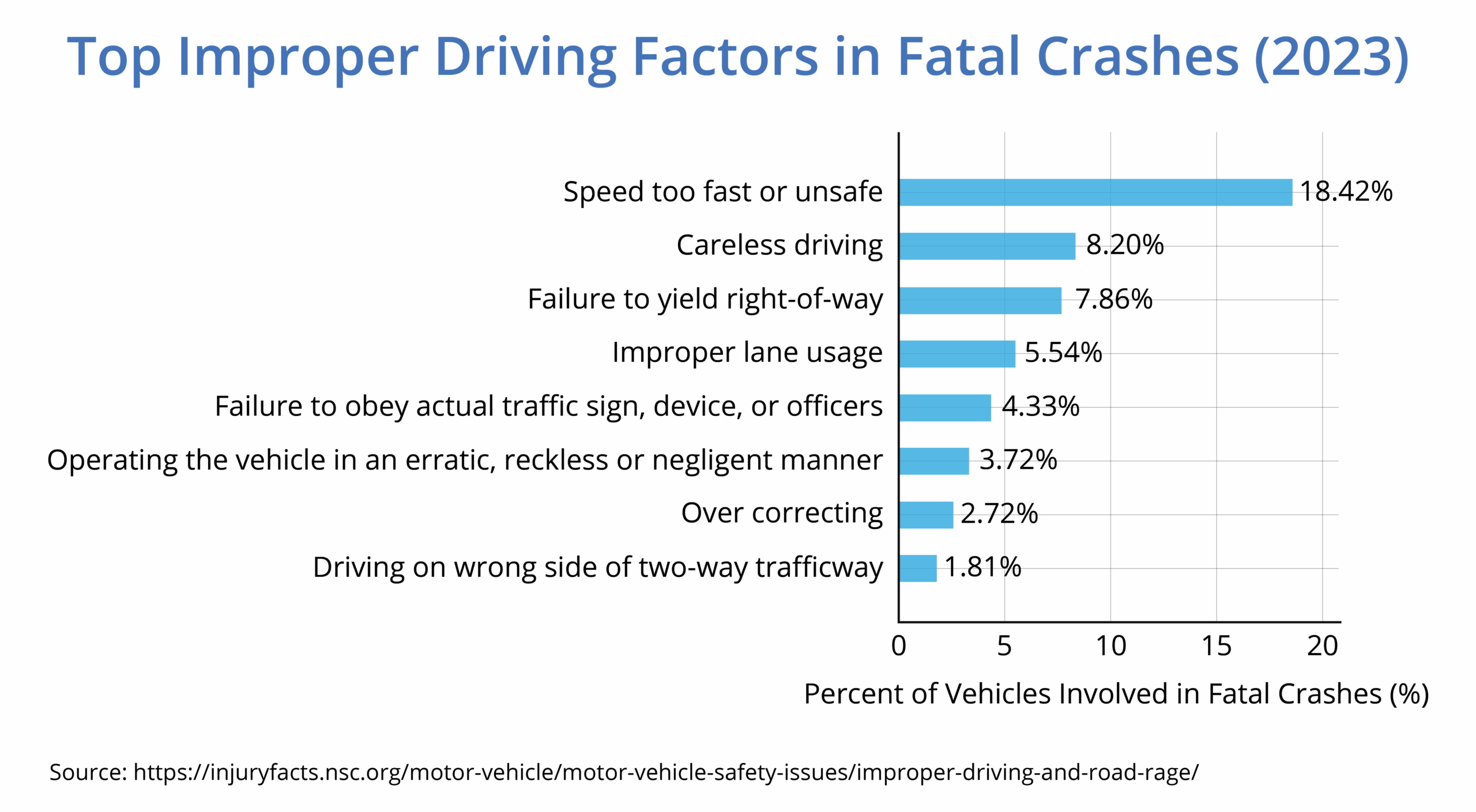
Source: NSC
It can also take a toll on your wallet, resulting in hefty fines and higher insurance rates. Here’s what to expect if you are pulled over:
- Traffic ticket + fine: Violating CVC 21800 can result in a traffic ticket and a base fine of $238 plus administrative and court fees.
- Demerit points: Under the California DMV point system, failure to yield is a one-point violation. That may not seem like much, but the points can add up quickly and lead to license suspension. A one-point violation will stay on your record for three years.
- Higher insurance rates: Minor traffic offenses, such as failure to yield the right-of-way, can raise your insurance premiums by 20-30%. The elevated rates will be in effect for three years.
Failure-to-yield accidents may even lead to imprisonment. Plus, the victims may request compensatory damages for pain and suffering, disfigurement, income loss, and more.
What to Do about a 21800 CVC Ticket
The best way to handle a failure-to-yield citation depends on your circumstances. You could pay the fine, go to traffic school, or contest the ticket.
Here’s what you should know about each of these options.
Pay the Fine
The easiest option is to pay the fine and be more careful in the future. However, if you go this route, the point will stay on your DMV record for three years. As a result, it could increase your insurance rates and push you closer to license suspension.
Fight the Ticket
If you believe that the citation was issued in error, it may be worth fighting it in court. Alternatively, you can request a trial by written declaration so you don’t have to appear in front of a judge.
In either case, it’s necessary to gather supporting evidence, such as dashcam footage, witness statements, or photos of the intersection to build your defense.
For example, if you’re cited under CVC 21801, you may argue that you were already in the intersection when the light changed and, therefore, you had the legal right to finish your turn.
You could also opt to hire a traffic lawyer to help. However, this can get expensive and may not be worthwhile for one-point infractions.
Read: How Much Does a Traffic Lawyer Cost?
Go to Traffic School
The last – and often best – option is to go to traffic school. It’s affordable, takes as little as three hours, and will remove the point from your license, preventing your insurance from going up.
The course is easy. It’s just 12 modules, each followed by a 4-question quiz. The 25-question final exam is easy too – 99.9% of our students pass on the first try.
Check out our Best Online Traffic School reviews. Most of our students say they find traffic school helpful. It’s not just a means to clean up your driving record, but an opportunity to refresh your knowledge of traffic laws and learn new techniques that could save your life.
Read: How Traffic School Works and Is Traffic School Worth It?
Why Choose Best Online Traffic School?
We’re an officially licensed California traffic school with a track record of success. Our online traffic safety course is DMV-approved and accepted by all state courts in all counties, including Orange County, San Diego County, and Santa Barbara County.
Once enrolled, you can study from any device and reach out to our team around the clock. Finish in one sitting, or take your time and go through each lesson at your own pace.
Meanwhile, take advantage of the perks available to you, including:
✅ Unlimited retakes
✅ Free audio read-along in English, Spanish, and Chinese
✅ Interactive learning materials
✅ Save-and-resume feature
✅ Open-book final exam
✅ Free electronic certificate
✅ Same-day certificate submission to the DMV and court
Our all-inclusive flat fee of only $27.99 covers everything you need to complete traffic school. In fact, we’re so confident in our learning method that we won’t charge you a penny until you pass.
Traffic school is available to drivers charged with one-point violations, such as failure to yield. Check your traffic school eligibility, confirm with the court, and then register for our course – no credit card required.
Maintain a clean driving record with Best Online Traffic School. Start our traffic safety course for FREE.
